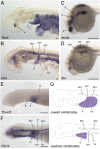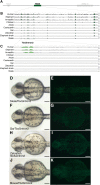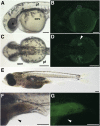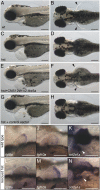Regulatory evolution of Tbx5 and the origin of paired appendages
- PMID: 27503876
- PMCID: PMC5018757
- DOI: 10.1073/pnas.1609997113
Regulatory evolution of Tbx5 and the origin of paired appendages
Abstract
The diversification of paired appendages has been a major factor in the evolutionary radiation of vertebrates. Despite its importance, an understanding of the origin of paired appendages has remained elusive. To address this problem, we focused on T-box transcription factor 5 (Tbx5), a gene indispensable for pectoral appendage initiation and development. Comparison of gene expression in jawless and jawed vertebrates reveals that the Tbx5 expression in jawed vertebrates is derived in having an expression domain that extends caudal to the heart and gills. Chromatin profiling, phylogenetic footprinting, and functional assays enabled the identification of a Tbx5 fin enhancer associated with this apomorphic pattern of expression. Comparative functional analysis of reporter constructs reveals that this enhancer activity is evolutionarily conserved among jawed vertebrates and is able to rescue the finless phenotype of tbx5a mutant zebrafish. Taking paleontological evidence of early vertebrates into account, our results suggest that the gain of apomorphic patterns of Tbx5 expression and regulation likely contributed to the morphological transition from a finless to finned condition at the base of the vertebrate lineage.
Keywords: Tbx5 enhancer; development; evolution; paired fins.
Conflict of interest statement
The authors declare no conflict of interest.
Figures















Similar articles
-
Zebrafish tbx5 paralogs demonstrate independent essential requirements in cardiac and pectoral fin development.Dev Dyn. 2013 May;242(5):485-502. doi: 10.1002/dvdy.23953. Epub 2013 Mar 27. Dev Dyn. 2013. PMID: 23441045
-
Distinct tissue-specific requirements for the zebrafish tbx5 genes during heart, retina and pectoral fin development.Open Biol. 2014 Apr 23;4(4):140014. doi: 10.1098/rsob.140014. Open Biol. 2014. PMID: 24759614 Free PMC article.
-
Identification and characterisation of the developmental expression pattern of tbx5b, a novel tbx5 gene in zebrafish.Gene Expr Patterns. 2010 Jan;10(1):24-30. doi: 10.1016/j.gep.2009.11.003. Epub 2009 Nov 17. Gene Expr Patterns. 2010. PMID: 19925885
-
New frontiers in the evolution of fin development.J Exp Zool B Mol Dev Evol. 2014 Nov;322(7):540-52. doi: 10.1002/jez.b.22563. Epub 2014 Feb 12. J Exp Zool B Mol Dev Evol. 2014. PMID: 24677573 Review.
-
Acquisition of the paired fins: a view from the sequential evolution of the lateral plate mesoderm.Evol Dev. 2012 Sep-Oct;14(5):412-20. doi: 10.1111/j.1525-142X.2012.00561.x. Evol Dev. 2012. PMID: 22947314 Review.
Cited by
-
Development of hypobranchial muscles with special reference to the evolution of the vertebrate neck.Zoological Lett. 2018 Feb 18;4:5. doi: 10.1186/s40851-018-0087-x. eCollection 2018. Zoological Lett. 2018. PMID: 29468087 Free PMC article.
-
Limb positioning and initiation: An evolutionary context of pattern and formation.Dev Dyn. 2021 Sep;250(9):1264-1279. doi: 10.1002/dvdy.308. Epub 2021 Feb 15. Dev Dyn. 2021. PMID: 33522040 Free PMC article. Review.
-
Towards a Better Vision of Retinoic Acid Signaling during Eye Development.Cells. 2022 Jan 19;11(3):322. doi: 10.3390/cells11030322. Cells. 2022. PMID: 35159132 Free PMC article. Review.
-
The genetic basis of novel trait gain in walking fish.bioRxiv [Preprint]. 2023 Oct 14:2023.10.14.562356. doi: 10.1101/2023.10.14.562356. bioRxiv. 2023. Update in: Curr Biol. 2024 Oct 7;34(19):4339-4348.e6. doi: 10.1016/j.cub.2024.08.042. PMID: 37873105 Free PMC article. Updated. Preprint.
-
Muscle development in the shark Scyliorhinus canicula: implications for the evolution of the gnathostome head and paired appendage musculature.Front Zool. 2017 Jun 21;14:31. doi: 10.1186/s12983-017-0216-y. eCollection 2017. Front Zool. 2017. PMID: 28649268 Free PMC article.
References
-
- Thacher JK. Median and paired fins, a contribution to the history of the vertebrate limbs. Trans Conn Acad Arts Sci. 1877;3:281–310.
-
- Mivart S. Notes on the fins of elasmobranchs, with considerations on the nature and homologues of vertebrate limbs. Trans Zool Soc Lond. 1879;10:439–484.
-
- Balfour FM. On the dedopment of the skeleton of the paired fins of Elasmobranchii, considered in relation to its bearings on the nature of the limbs of the vertebrata. Proc Zool Soc Lond. 1881;49(3):656–671.
-
- Gegenbaur C. Elements of Comparative Anatomy. MacMillan and Co.; London: 1878.
-
- Goodrich E. Studies on the Structure and Development of Vertebrates. MacMillan and Co., Limited; London: 1930.
Publication types
MeSH terms
Substances
LinkOut - more resources
Full Text Sources
Other Literature Sources
Molecular Biology Databases

